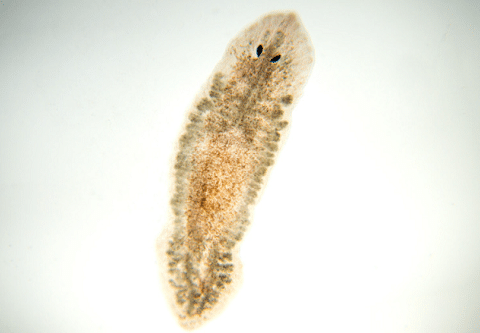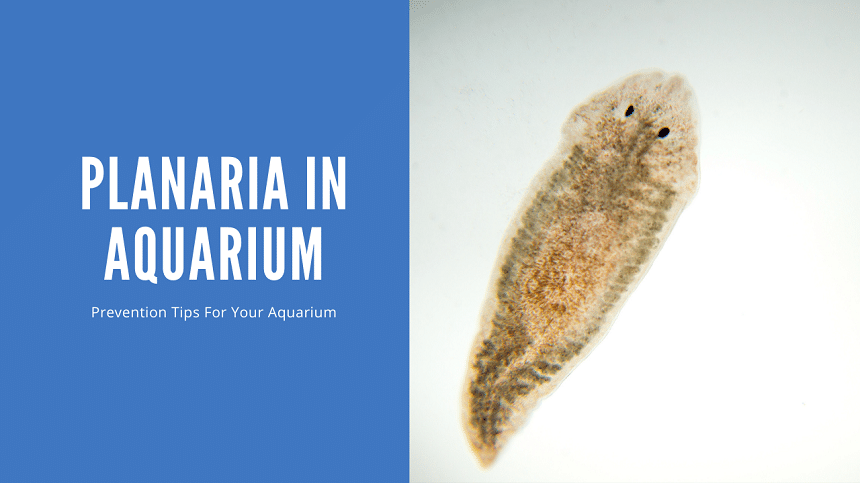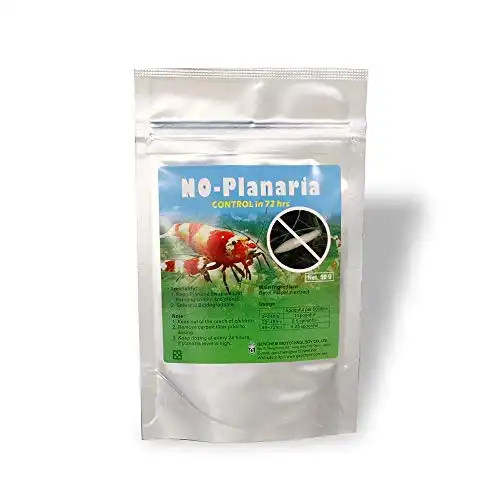Thank you for visiting! By the way… any links on this page that lead to products on Amazon and other stores/partners are affiliate links Aquarium Store Depot earns a commission if you make a purchase.
If you are a planted tank, shrimp tank, or reef keeper, you may be familiar with planaria. Planaria are small, flatworms that can invade and wreak havoc on your aquarium. In this blog post, we will discuss the prevention and treatment of planaria in aquariums. By following these tips, you can keep your fish tank healthy and free of these pesky worms! Let’s start with our first question…
What Are They?
Planaria are commonly known as flatworms. These animals belong to the Turbellaria class and the larger phylum of Platyhelminthes1. They can be found in a variety of ecosystems, including freshwater, brackish water, marine, and even in humid terrestrial settings. There, they play an important role in the ecosystem and can even be used as a bioindicator for the conditions of the environment. Though Planaria are abundant, they are actually quite sensitive to poor environmental conditions.
In addition, species of Planaria exhibit regeneration. These incredible animals are able to regenerate a new independent flatworm from just 1/200th of a piece; if split in two, the head piece will develop a tail while the tail piece will develop a head. Planaria also share some genetic similarities with humans, making flatworm bioindication and regeneration a hot topic of scientific study and application.
Because flatworms are so small and elusive, it’s impossible to know how many species exist, though rough estimates are about 4,500 unique worms. One thing is for sure though, they have happily made their way into the home aquarium.
What Do They Look Like?
If you have a planted tank or reef setup, you probably have aquarium worms in your aquarium whether you like it or not. While most species of Planaria flatworms are harmless, the good ones are difficult to tell apart from the bad ones. This is why it’s recommended to remove and treat for planarian flatworm if you find one in your aquarium regardless.
First, you need to know what one of these small worms looks like.

Planaria flatworms are named after their flat bodies. These animals are dorsoventrally compressed, meaning they have flattened bodies from both the under and upper sides. One of their main characteristics is their triangular head, which usually has two observable eyespots.
Flatworms are very small and typically stay well under half an inch in length. There are a few types of planaria worm found in the aquarium:
- Light Planaria, sometimes called white Planaria or white worms, are typically species from the Procotyla genus. They are freshwater worms from North America and Russia. They are very light and creamy in color, though they might have bursts of darker color across their bodies.
- Dark Planaria are often Dugesia species, which are much more widespread throughout the world and are found in freshwater ecosystems.
- Red flatworms (Convolutriloba spp.) are one of the most common marine Planaria worms to come across. They reproduce quickly and can quickly suffocate corals. When killed, these rust-colored worms also release a toxin that can become dangerous to other aquarium inhabitants. Interestingly, red flatworms are largely photosynthetic.
Keep in mind that Planaria flatworms are typically only a few millimeters in length, making them incredibly difficult to accurately identify. Planaria flatworms are not the only worm in the aquarium though, and lots of other aquatic worms are beneficial to our systems.
It can be easy to confuse Planaria worms with detritus worms that live in the substrate, cleaning up leftover food and providing oxygenation. Detritus worms will typically stay in the substrate or along the bottom of the aquarium and have a long and thin rounded body. This is much different from the flattened appearance of a flatworm.
Planaria In Aquarium? How Do They Get In
Planarian worms are hitchhikers just like any other creature that has unknowingly made its way into your aquarium. They show up in your aquarium one day, fully established.
Like other hitchhikers, Planaria flatworms enter the aquarium through direct transfer of rock, media, substrate, plants, or other aquarium decorations. It is also possible that Planaria eggs are transferred on these objects which will then hatch in the new aquarium. On rare occasions, Planarian worms and eggs may be transferred with the aquarium water.
Like many other pests, Planaria populations will largely depend on the overall resource availability of the fish tank; population numbers may increase and decrease depending on water quality and feeding frequencies. While it’s normal to find one or two Planaria flatworms every now and then, you might find yourself facing an infestation.
No matter how many worms you observe in your aquarium, it is always recommended to remove them as soon as possible. This is mainly to prevent an infestation but also because it can be hard to know if the type of flatworm you have is harmful to your system or not. It is better to prevent a problem before it happens than to clean up the mess.
Are They Harmful To Fish?
But how harmful are Planaria worm species? Will they kill your fish and invertebrates overnight or wait until you least expect it to strike?
No, it is very unlikely for Planaria to affect your fish and larger invertebrates, like shrimp and snails (and also crabs); at the same time, Planaria have been known to attack and kill shrimp (see video above). While some species of Planaria are parasitic, they are rarely seen in the home aquarium. Instead, most fish tank Planaria species are free-living, burrowing into the rocks and substrate.
These free-living Planaria worms can become problems, especially for corals. One of the most common pests is the red Planaria worm, which reproduces quickly and suffocates corals. However, there are other types of flatworm that target specific species of coral, like the Acropora eating flatworms (AEFW).
These flatworms, Amakusaplana acroporae, are nearly impossible to see before it’s too late. AEFW flatworms feast on the coral’s flesh and then lay their eggs around the base of the skeleton. These Planaria worms are nearly the exact same color as the Acropora they eat, making them blend in and camouflage an already bare coral skeleton.
On the other hand, a controlled Planaria population can be beneficial for the home aquarium. These worms are excellent members of the cleanup crew and are a high-protein source of food for many fish species, especially wrasses. With careful feeding and regulation, these pests can be put to good use.
How To Get Rid of Worms
The problem is that by the time you find one Planaria swimming across the front of your aquarium glass, you already have a problem. Remember, these worms reproduce quickly and one can quickly lead into a full Planaria infestation.
Because these worms are so small, removal can be difficult. Luckily, there are a few methods to get rid of Planaria worms through manual removal, chemical treatment, or the addition of new aquarium inhabitants.
Manual Removal Of Flatworms
Manually removing flatworms is like treating any other pest and requires determination and consistency.
However, it’s important to keep in mind that some Planaria worms are capable of releasing toxins into the aquarium upon death, which should be avoided as much as possible. For extra precaution, make sure to run activated carbon filter media.
Otherwise, these worms can be carefully removed from the aquarium over the course of a few weeks.
Aquarium Vacuuming
Remove worms as you see them. If you find one crawling along the aquarium glass, carefully use a net or other container to get it out of the fish tank. This might seem simple enough, but it’s also worth taking a few extra minutes during a water change to suck up any flatworms that you see on corals, rocks, or plants with an aquarium vacuum.
Some species, like the red flatworm, are easier to remove than others. After safely removing them from the tank water, they may be disposed of through specialized coral dips, boiling water, or other proven household chemicals.
At the same time, feedings should be decreased. As mentioned before, a blossoming Planarian worm population is often directly linked to food availability. By limiting food temporarily while also undergoing population control, eliminating flatworms becomes a whole lot easier.
Flatworm Traps
Because hobbyists regularly struggle with flatworm infestation scares, tools have been developed to make the solution as easy as possible. One of these tools is a planaria trap.
These traps come in many shapes and designs and may even be DIY’d. The main goal is to draw as many worms as possible by using extra smelly bait and leftover food. The Planaria trap is designed to allow the flatworms to enter but not to leave, letting hobbyists leave their aquariums alone to catch worms for them.
The problem with the Planaria trap is that it can attract other smaller invertebrates and cleanup crew, like adult shrimp and other worms. Though the trap won’t kill them immediately, it makes predation easier while also stressing out the animals.
The other problem with using a Planaria trap is that progress is slow and indefinite. These traps will not get rid of a Planaria infestation. Instead, they can regularly be used for population control.
Chemical Treatment
If your Planaria infestation is literally out of your hands, then you may need to turn to a more immediate solution. However, chemical treatment should be a last resort as products designed only for Planaria worms can be difficult to find and dose. Luckily, there are a few products that only affect Planaria, though they might originally be meant for other animals.
The best chemical treatments for eliminating Planaria are:
- Praziquantel. This treatment is generally safe for most fish species, though wrasses might be more susceptible to negative side effects. It may kill fan and bristle worms but should not affect other invertebrates in fish tanks.
- Salifert’s Flatworm Exit. This chemical is one of the safest for all reef organisms, but can sometimes be ineffective at normal doses. This makes it so that you need to overdose on the product, which can lead to a mass die-off of worms that then release too many toxins that affect the whole tank.
- Levamisole hydrochloride. Products that have this active ingredient are Levisol, Fenbendazole, Safe-Guard, and Paracur. These chemical treatments offer wide coverage and will kill most invertebrates in the aquarium and should be used as a last resort.
- Interceptor. A canine dewormer that is used for reef tanks to eliminate flatworm infections
- No Planaria. This is a shrimp-safe treatment that works for heavy infestations. Make sure to remove beneficial aquarium snails and chemical media when using this product. The active ingredient is Betel nut palm extract. This is a natural treatment that can be effective against planaria in the aquarium.
A shrimp safe treatment that works to eliminate Planaria from your aquarium. Great for battling infestions
While these chemicals can be extremely effective, most do not treat for Planaria eggs. This is why it’s recommended to quarantine all new live rock (for saltwater tanks), plants, substrate, and filter media that is being transferred from one aquarium to another.
New Fish And Invertebrates
One of the best things about having Planaria worms in your aquarium is having an excuse to buy new fish and invertebrates. Like any other solution for pests, new aquarium inhabitants should not be purchased for a temporary solution. Fish and invertebrates should be given what they need for an indefinite time period.
That being said, there are a few natural predators that eat Planaria in Freshwater tanks.
Freshwater Angelfish
- Scientific Name: Pterophyllum spp.
- Minimum Tank Size: 30 gallons
- Maximum Size: 6 inches
- Aggression: Semi-Aggressive
Freshwater angelfish are big, colorful fish that can work up an appetite. These fish are largely categorized as omnivores but can go into a frenzied state when live, meaty foods are introduced into the aquarium.
This can be used to the benefit of the hobbyist as freshwater angelfish are likely to go after flatworms to supplement their diet. Though these fish aren’t the most proactive hunters, they can certainly help keep worm populations under control.
Once flatworm populations run low, angelfish can then sustain themselves on other foods instead.
Gouramis
- Scientific Name: Trichogaster spp.
- Minimum Tank Size: 10-40 gallons
- Maximum Size: 6 inches
- Aggression: Semi-aggressive
Gouramis and angelfish have very similar diets and are just as capable of controlling a flatworm population in the fish tank. These colorful fish species will gladly eat any flatworms they come across, and won’t need to be supplemented in the future.
Again, gouramis will not eliminate the problem completely but will help keep numbers down.
Tiger Barbs
- Scientific Name: Puntius tetrazona
- Minimum Tank Size: 30 gallons
- Maximum Size: 3 inches
- Aggression: Semi-Aggressive
In a school, tiger barb behavior has sometimes been equated to that of a hungry pack of piranhas, and they definitely have the predatory instincts to prove it!
Like angelfish, tiger barbs go into a frenzy when food is present. They are largely omnivores but will prefer a more meat-based diet, making them the perfect candidate to eat Planaria worms. The only problem can be their over-aggression, which limits tank mate options.
Assassin Snails
- Scientific Name: Clea helena
- Minimum Tank Size: 30 gallons
- Maximum Size: 3 inches
If you’re pressed on space or just can’t add another fish to your aquarium, then an assassin snail might be what you’re looking for. However, these snails won’t go after flatworms on their own and they might need some encouragement; all the while, it’s likely that your assassin snail will attack any other snails in the aquarium.
In order to get your assassin snail to target flatworms, it’s recommended to feed the tank less. This will make your snail hungrier and possibly more interested in the prey that is already available.
It should be noted that this is not a guaranteed method but can help hobbyists keep up with manual removal.
Saltwater solutions
In general, wrasses and blue velvet nudibranchs (Chelidonura variants) are the best biological solutions to get rid of Planaria worms. The six line wrasse (Pseudocheilinus hexataenia), melanurus wrasse (Halichoeres melanurus), yellow coris, and canary wrasse (Halichoeres chrysus) are especially known for their flatworm-eliminating powers.
Planaria worms are great food for fish and most species of wrasse won’t turn down a free meal. Unfortunately, wrasses are active fish that need more space than the blue velvet nudibranch. They also prefer a substrate that they can burrow into at night.
Other Options
Hobbyists have also tried some species of dragonet and blenny, but both these fish seem to be more interested in other food in the aquarium first.
Some hobbyists have even tried peppermint shrimp (Lysmata wurdemanni) that are successful Aiptasia hunters. However, they’re just as likely to move on to other foods first than to fully control Planaria worm populations in the aquarium.
Quarantine And Prevention
The best way to prevent a Planaria worm outbreak is by stopping them from entering your freshwater or saltwater aquarium in the first place. This can be done by quarantining new live rocks, plants, filter media, and other aquarium decorations. Preventative dips may also be used for faster results.
With any new addition to the aquarium, a quarantine period should be allowed. This should last about 2-4 weeks to allow worms to emerge and for any eggs to hatch. At this point, the problem is contained and can be freely treated with any of the methods mentioned before: manual removal, chemical treatment, or added fish and invertebrates.
The benefit of quarantine is that you don’t need to worry about sensitive fish or invertebrates that would otherwise be affected by the most effective chemical treatment options. You also don’t need to worry about nuking your tank with dead Planaria!
The quicker method (for saltwater tanks) is rinsing new objects and media in a coral dip or other homemade solution. There are many coral dips that will treat a variety of pests, including flatworms.
An alum dip is especially popular for dipping and treating freshwater live plants.
While these dips are largely effective, some worms have grown immune to their effects. Planarian eggs may also not be affected and may need to be manually removed.
Final Thoughts
Planaria flatworms aren’t something you want to see in your aquarium, but they’re not the most destructive or overwhelming pest. Luckily there are a few methods to get rid of Planaria worms, including manual removal, chemical treatments, and new aquarium additions.
As with any pest, prevention is the best way for eliminating flatworms altogether.
- About the Author
- Latest Posts
I’m thrilled that you found Aquarium Store Depot! Here you’ll find information on fish, aquariums, and all things aquatics related. I’m a hobbyist (being doing this since I was 11) and here to help other hobbyists thrive with their aquariums! I adhere to a high quality Editorial Process and Review products with real life field usage and practical analysis.






